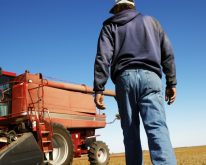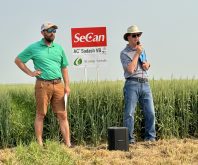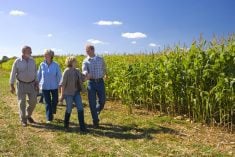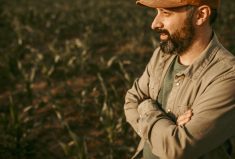This past spring, Michel Dignard carefully walked his saturated soybean fields, counting the thin, yellowing plants while some were still fully submerged in water. It was emotionally exhausting work, but at least Dignard and his wife Jeannette Mongeon knew what they would do next.
They crunched the numbers. They added up the costs and yield outlook of re-establishing the field versus taking the damaged field to harvest, also taking crop insurance coverage into account in order to see if there would be an economic return to re-planting.
Read Also

Youth motivated to find answers to today’s agricultural challenges
This is the first in a series of articles exploring the perspectives and experiences of young people who are finding…
It’s a straightforward example, but maybe the lesson that comes out of it isn’t, because Dignard and Mongeon also remember how the act of putting the situation on paper and working the calculations helped make their path to a decision clearer, and how the stress of discussing it between them floated away.
They tore up the field and replanted, and by the beginning of September, when Country Guide touched base with them, it looked like it had been the right decision, especially if the fall was to remain open and sunny.
In other words, they knew there wasn’t any guarantee because Mother Nature will do as she pleases, but the numbers on the paper had become a sort of unbiased third party that both of them respect.
Here’s the important point. Dignard’s and Mongeon’s sharp pencils are focussed on cost of production, but the numbers don’t hold back this farm. In fact, the opposite has happened: Their farm has become even more dynamic and is constantly progressing. Using financial management decision-making to analyze what-ifs empowers them to make changes.
In 2009 the couple decided to sell their dairy quota. Dignard’s recurring knee problems and the fact that the children weren’t interested in taking over that part of the operation spurred the decision.
At about the same time, Dignard took the CTEAM course, developing his knowledge of financial management. The course also gave him skills in other areas too, and he says he actually got the most out of learning about human resources. “I had milked cows for 45 years but I needed the social skills to deal with people.”
CTEAM is a two-year program for Canadian farmers that focuses on financial management. The next intake deadline is the end of November.
More recently, Dignard has also taken the Advanced Farm Management course offered through AMI in Ontario. (Registration deadline for this winter’s program is November 20, 2017.)
Embracing change
Once the decision was made to pull the plug on the dairy enterprise, Dignard and Mongeon decided to use the sale proceeds to expand their cropping operation, and their timing was good, buying some nearby land before prices started rapidly escalating.
Now they farm about 1,000 acres of corn, wheat and soybeans together with some intensive fruit including seven acres of blueberries and 20 acres of raspberries and a small apiary.
They also had layer quota but sold it in 2012 and leased out the barn.

Additionally, they renovated an old heifer barn into rabbit production facilities, and now they have 300 does in a 10,000-sq. ft. facility. At first, they considered simply running a feeder operation for rabbits until they ran the cash flow for the enterprise and learned it wouldn’t be profitable enough.
So they started asking questions and looked at that industry globally, finding that rabbit farms in Europe had much higher productivity. Instead of just giving up on the idea, Mongeon figured out how to import breeding stock from France where the litter size is double the average here. With this higher production, projected profits justified the investment.
The decision to get into rabbit farming literally hopped off the page.
Now they’re supplying producers in this country with high-producing breeding stock and they continue to fine-tune their own production with the goal to double the number of rabbits produced per month to 1,000 from their current 500.
All of the rabbit profits so far have been reinvested back into the enterprise as they want to carry $0 debt with this enterprise, says Dignard.
Excelling
When Mongeon married Dignard, she brought skills to the farm that she had honed during her 25-year career at the bank. “I was raised on spreadsheets,” she says.
At that time Dignard had not been interested enough in the financial workings of the farm to even bother with a budget. It took them two or three years to put financials from all the farm enterprises on Excel spreadsheets.
They use Simply Accounting and have a bookkeeper input all the data, with strict instructions on which accounts to use for which expense and income entries.
Now their cash-flow statements come directly from that accrual information with links to the separate spreadsheets for each enterprise, and they can quickly see their costs of production for each bushel or kilogram of production.
They operate the farm themselves, so don’t have time for anything more complex, says Dignard. “It’s not the complicated fancy stuff,” he says. “It’s real life.”
Every two weeks Mongeon updates those spreadsheets and together they review them. Since they’re constantly reviewing each enterprise on the farm, both of them know the situation and nothing gets too far ahead of them to turn things around.
They also modify entries on those linked spreadsheets to see the impact not only on their cost of production (COP) but on the whole farm’s net income. COP is their pivot point for most of the decisions.
But if this is how they’re managing now, what would their ideal future system look like?
It would be a financial system that marries all the aspects of their farm seamlessly, and give more information faster. “Inventory scanning, automatic paystubs, ratios instantaneously… ” says Mongeon with a sigh of longing.
Their current process allows for more timely financial management and real-life numbers to become the launching pad for discussions.
This couple knows how to leverage each other’s strengths, how to push each other to keep learning, to keep questioning, and to justify their ideas. As a result both of them deeply understand the impact of short-term and long-term decisions.
They also both have confidence and passion because each decision has been thoroughly considered, compared and tracked to ensure profitability and sustainability.
For example, several years ago they looked at their corn: soybean rotation comparing three years of data for things like yields, profitability and market volatility. At the time their rotation was about half of each crop. When they looked at their actual numbers, they found the risk versus reward of growing soybeans was much higher than for corn in their area because of their soil type and early frosts. They decided to change their goal to 75 per cent corn and 25 per cent soybeans and have already moved to a 60:40 mix.
Since the couple are both actively farming and making tough decisions together, they’ve found that the discussions are easier if they start with the spreadsheet — neutral territory. “Good papers make for good relationships,” says Mongeon.
In fact, they encourage each other to have differing opinions, but those opinions have to be backed up, they have to do their homework, and most importantly they’re not offended when one questions the other. Disagreeing is encouraged, so they can see more sides of the problem. “A complaint is a gift,” says Mongeon. “It makes you understand better, more.”
Using financial books as a platform to communicate has been extended to the couple’s five children. One daughter is studying agriculture at local Alfred College and as part of the course she needed her own family farm’s financial statements. “It helped me open up to her,” says Dignard. “Our daughter now realizes how her parents made decisions,” adds Mongeon.
Annually they review the whole farm’s financial position and the impacts of any changes they made in the past. They review the good, the bad and what needs improving, says Mongeon. “The impact of some decisions can last for years,” she says.
One thing that she has learned to do is to write down wishes and improvements as they go, right on the spreadsheet. And to highlight anything they need to examine. That list of to-dos helps build their agendas and their plans for the upcoming year.
However, not all decisions are purely financial. Often there are other things to consider, the human factors, the perceived future, the skill set of the managers, adopting new technology, even reorganizing to improve efficiency.
For example, buying a new tractor might not make sense financially but it does make sense if it replaces someone who wants to slow down or if it keeps employees happy because there’s air conditioning.
“Twenty to 25 per cent of a decision you can’t put on paper,” says Dignard.
However, says Mongeon, if they are aware of what factors are contributing to that 20 per cent, they can try to run risk management to address those factors. Understanding that portion of the decision makes them look at the people and at the non-financial things that are driving the decision and may jeopardize the choice. “We look for a backup route,” she says. “I learned at the bank to inspect what you expect.”
“We don’t mind taking chances,” says Dignard. “But you just have to be smart about it.”















